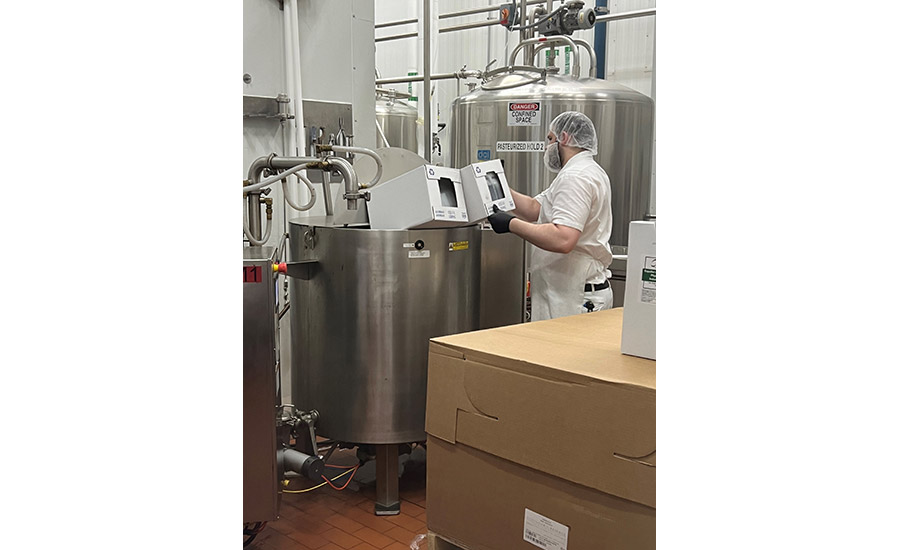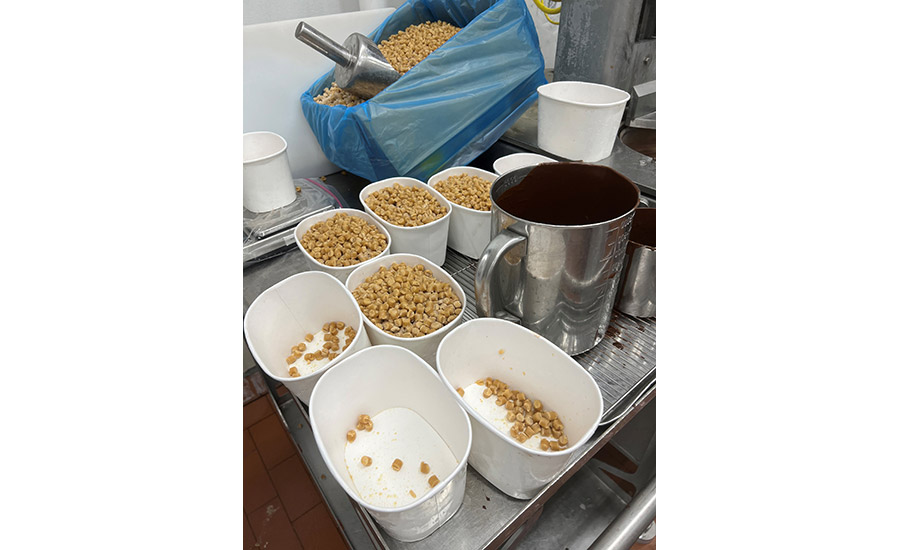Graeter's Ice Cream success surpasses 150 years and counting
Dairy Foods gets an-all look at the Cincinnati processor’s plant.

Article photos by Brian Berk
Cincinnati-based Graeter’s Ice Cream has served the Midwest since 1870. Dairy Foods visited the plant in April to check out its 30,000-square-foot manufacturing facility, opened in 2010.
Dairy Foods first visited the plant, located at 1175 Regina Graeter Way in the Bond Hill section of Cincinnati, in 2011. Upon arrival 13 years later, Graeter’s proudly displayed that 2011 article in its conference room, as well as its 2011 Plant of the Year award we bestowed upon the company that same year.
During our visit, we got to taste Graeter’s seasonal Strawberry Chocolate Chip, as well its new Lemon Meringue Pie flavor. However, on the date of our visit, plant employees were hard at work processing Buckeye Blitz Chocolate Chip, which features a logo of The Ohio State University, thanks to a licensing arrangement with the college.
Depending on the time of year, Graeter’s often offers well more than 30 flavors at a time, some of which are seasonal. Over the course of a year, the Cincinnati processor produces more than 50 flavors.
“We have a core of about 30 flavors we always offer,” says Robert Graeter, fourth-generation family member, owner, and company vice president. “We also have a line of animal-free dairy and sorbet.”
After we put on a hairnet and booties, we made our way to the Tote Room, and learned details about ice cream formulation. Impressively, Graeter’s formulation has changed little in the past 154 years.
“We made some tweaks in the early 2000s, but since then, it has basically remained the same,” states Graeter.

To produce ice cream, Graeter’s, which employs 110 people. Of course, it first must have milk, which it obtains from dairy partners, including supermarket chain Kroger and dairy processor Prairie Farms.
The process
Graeter’s starts its day at 9 p.m., after sanitation completes its work. It typically starts by processing ice creams that are light in color, followed by richer, darker flavors. “For example, on a typical night, we might start with vanilla and then transition into chocolate chip, black raspberry, or strawberry,” Tom Kunzelman, vice president of manufacturing, affirms. “After two shifts, we will have a pre-shift meeting, a sanitation shift, and then go back into production.”
Graeter’s only processes ice cream and sorbet at its dairy plant, with no plans to add any other type of dairy product offerings in the future. However, unlike some competitors, Graeter’s makes some of its own bases.
“We have a portfolio of bases that we add to our mix,” Graeter says. “We also have an egg custard product that we add to every flavor that consists of sugar, milk, and egg, which we make efficiently with a high-shear mixer.”
We then got to view the high-shear mixer, which can be controlled electronically. That was the start of a look at the entire operation, which included in a sight reminiscent of what could appear in a Willy Wonka movie, an employee placing huge bars of chocolate into a temperature- controlled tank to melt the chocolate.
“We blend the chocolate with oil, melt it, and then dispense it into smaller units that we put on the production floor and dispense from for addition to the ice cream,” Graeter notes.
Although cocoa prices are rising, something that could provide a concern for many dairy processors, Graeter confirms the company is in a very good position right now, “but next year could be challenging unless that market changes,” he acknowledges. “About half of our production is in chip flavors. It will raise the cost to make our ice cream. The question is how much? Fortunately, we are getting a good price for our ice cream and are able to put more value into our ingredients.”
The key attraction of the Graeter’s plant is witnessing the French pots in action. Graeter’s separates itself from the competition with this unique process. Graeter’s uses a two-gallon batch process to freeze the product that is a slow, methodical way of processing ice cream, but yields a tremendous reward with smooth, creamy ice cream.
“We take two gallons of mix, freeze it into French pots, add inclusions and chips by hand, and actually take the product out by hand with a paddle,” Graeter explains.
During our visit, all 41 two-gallon French pots were in action. Graeter’s uses a skill block system, whereby it has eight French pots in a pod, each staffed by three employees. Technician No. 1 in the pod knows all the nuisances of making ice cream; Technician No. 2 knows the same information plus the nuisances of packing; while Technician No. 3 knows all of the above and also oversees the process.
A production planner writes the schedule every day and balances the inventory with a demand forecast for the entire year. “In September at the end of summer, we generally hit our low point in inventory for the year. Inventory can fluctuate throughout the year from as little as 150,000 gallons to 300,000 gallons,” Kunzelman relays. “Inventory is often driven by our retail store sales. Of course, we are not going to sell the same volume of ice cream as we will in the summer months.”






Buckeye Blitz Chocolate Chip was being processed on the date of our visit. This collage also features Graeter's famous French Pot process, plus much more.
Hence, July and August are the months of greatest demand for Graeter’s ice cream, with demand slowest in January and February, as expected. However, ice cream pints are year-round sellers. Kunzelman notes. December is specifically a strong sales month, as companies often turn to ice cream for corporate gifts.
Although Graeter’s primarily sells pints, it does offer a limited number of scrounds.
Inside the plant
Twenty-seven plant employees were working a 10-hour shift during our visit. Graeter’s plant operates five days a week, with each of these days having two 10-hour shifts. Employees can either choose to work four days a week with a revolving off day, or choose to work 50 hours a week, earning overtime.
Working on weekends is not typical, but has happened in the past based upon demand. However, Kunzelman confirms this has not been necessary for a couple of years.
As we witnessed, Buckeye Blitz Chocolate Chip offers a chocolate peanut butter base with peanut butter cookie dough and chocolate chips. If this sounds like a tasty, indulgent ice cream, that is certainly the goal.
“We are all about indulgence. It is high-fat, high-solids, low overrun, and high quality. Our sorbet is actually low overrun too. We use a very high percentage of fruit juice in our sorbet,” Graeter says.
The ice cream packing process is unique also. Every ice cream pint is hand-packed, something we witnessed. Due to the labor involved, employees often switch roles throughout the day at the plant. Hence, someone hand-packing ice cream will switch to a different role during the day.
Kunzelman notes that new employees need about a week to understand the plant process. “For the first few weeks here, they learn the ropes,” he notes. “We like to build inventory as demand goes way up in the summer months.”
These efforts have worked. Attrition is currently only about 15%. “That’s something we have worked really hard on the past four or five years,” Kunzelman confirms. “We have a stable workforce.”
This stable workforce includes many long-term employees. In fact, Bud Curry, a legendary plant employee, retired three years ago after serving Graeter’s for 35 years.
“We have an employee now who has been here for 30 years. We really ramped up employment when we moved to this new plant in 2010,” notes Kunzelman. “We now have 60 people who work in the ice cream department. So, we have a lot of people who have been employed here for 14 years or more.”
Food safety
Like others, Graeter’s takes food safety very seriously. We got to see the Mettler Toledo x-ray metal detection machine in action. “We shut it down and test it every two hours. We always have to make sure it is functioning properly,” Kunzelman stresses. “We have a whole protocol if something is rejected. We melt it down and inspect it. If there is something valid [regarding an error with the product], we go back and do machine inspections.”
“The machine does a really nice job for us,” he continues. “We can even go back several days and determine why a problem happened.”
In the packaging room, Graeter’s ensures a plastic safety seal is placed on every pint. Ice cream pints are sold in eight-packs that make their way to Graeter’s retail locations, as well as grocery outlets. A bulk of the supermarket sales occur in the Midwest, but Graeter’s ice cream is also sold on both the east coast and West Coast, via such partners as Kroger and Fresh Market.
Every pint is also date-coded for traceability reasons. “If a consumer ever has a concern about a pint, we can trace it back to the exact production time of day and determine what happened,” Graeter notes.
These efforts are extremely important, considering Graeter’s processes, on average, more than 6 million ice cream pints per year.
For palletizing, Graeter’s uses a robotic process, which is fascinating to watch. A Schneider robotic case packer builds its pallets. “Once the pallet is completed, we take it to a shrink wrapper and then to a rack in our freezer,” Graeter states.
The pallets are also brought in and cleaned as well. “We try not to bring any wood pallets. We bring in plastic pallets and we have an extensive cleaning process,” Kunzelman maintains. “We have a quality team that works every shift, and we can do a lot of on-site quality testing here.”




Graeter's takes tremendous pride in producing premium products. Here, the company is inserting chocolate into a temperature-controlled tank.
There is a food quality aspect and a food safety aspect, both of which can be completed at the Cincinnati facility, he adds. “We can monitor the percentage of chips and weigh the product to make sure everything was made right [for example],” Kunzelman stresses. “This is done every shift.”
Graeter’s has not made many additions to the plant since 2010, but we did get to witness a freezer addition, offering a bone-chilling -20 F temperature. This room has tripled Graeter’s capacity for frozen storage.
It also expanded its shipping/receiving area, whereby it increased its docks and freezer space, reducing off-site storage and hence, logistical costs, Kunzelman notes. “We take very little off-site now,” he says.
Sustainability
Dairy Foods, which received an “all-access pass” to the Graeter’s plant, also got to check out where the company stores its chocolate. We also got to see a box of gourmet, ground vanilla beans sustainability sourced from Madagascar.
“We use this to flavor our ice cream. We can create a really intense, deep vanilla flavor to produce gourmet vanilla ice cream,” Graeter said, showing us the contents of the box. “These are very expensive boxes. One box is worth [many] thousands of dollars.”
Sustainability is a popular topic whenever we visit processors. Graeter’s acknowledges it heavily relies on its suppliers regarding sustainability. “We want our dairy suppliers to be efficient and sustainable. As a small company, we cannot change the weight of the world,” Graeter says. “But we do whatever we can. We recycle all plastic containers from shipments. Our retail ice cream for dipping is packed in plastic. We bring it back here, wash it, and recycle it to minimize the amount of waste that goes to landfill.”
Graeter’s also does whatever it can to cut back on water use. “We always look for the most energy-efficient process,” concludes Kunzelman. “We have very little waste. If we put 3,000 gallons in the tank, we make 3,000 gallons of ice cream.”
Looking for a reprint of this article?
From high-res PDFs to custom plaques, order your copy today!







